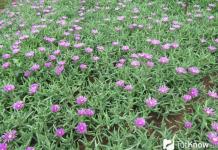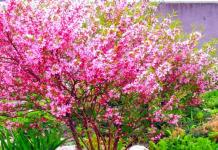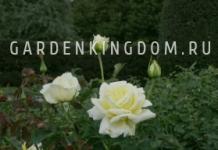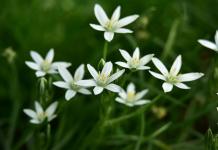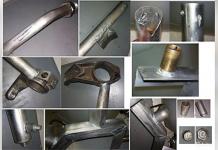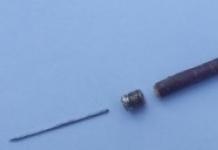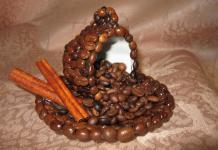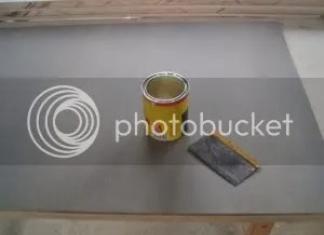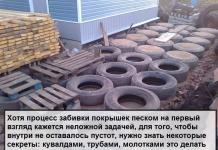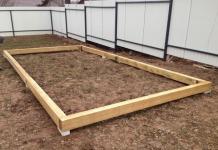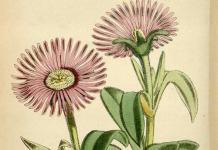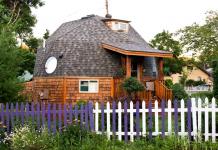South Africa.
flowering time
Late spring, summer.
Delosperma types
Cooper
Creeping, draft-resistant perennial succulent or semi-shrub with outstretched branches. Soft, fleshy, semi-cylindrical green leaves up to 5 centimeters long. Perfect for a rock garden or other landscaping.
It is an excellent ground cover plant. Brilliant, radiant pink-purple flowers up to 2 centimeters across, with white stamens. Blooms all summer.
Photo of a delosperm cooper flower.

cloudy
This kind forms a carpet from fleshy, evergreen shiny leaves, among which in late spring you can see many star-like small flowers. An excellent choice for hot, dry regions. Good as a groundcover, in a rock garden or on a wall, to form borders or as a lawn substitute.
Attractive to butterflies. Easily propagated by simply breaking off small pieces. They are easy enough to stick into the ground. New roots will appear in just a few weeks. Foliage turns bronze in autumn.

profusely blooming
This type forms many evergreen leaves and small stars of pink flowers with white stamens all summer long. It is an excellent groundcover for hot, dry slopes and will tolerate poor, sandy soil. It grows well in tubs and mixed containers, in rock gardens or used to form borders.

twisted
In delosperma twisted, as in the species listed above fleshy, evergreen leaves. Flowers in the form of small yellow stars. In winter, the leaves turn dark burgundy. Prefers light shade in the afternoon. In winter, good drainage is required, otherwise the plant will rot.
Good for a rock garden, rocky or alpine depression. Easily rooted in early summer.

Sutherland
An excellent perennial for the rock garden. undersized succulent with dark green, needle-like, shiny leaves that turn red in bright sunlight. From late spring it blooms with large, daisy-like bright pink or light purple flowers with yellow stamens. Blooms until early autumn.

Home care
Delosperma is evergreen outdoors only in temperate parts of zone 7. When growing in containers, protect from waterlogging and hard frost. The best place for wintering, planted in containers is a cold and dark room with a low level of humidity.
Over watering will kill the plant. When growing in the garden, make sure that the soil is well permeable. The plant should not be in water. Delosperm requires a well-lit place for normal growth.
Soil and planting
Light, well-drained soil will ensure good growth of delosperma. Container grown plants require high quality soil with an equal amount of coarse sand to provide drainage.
If planted in the ground outdoors, then the plants should be located thirty centimeters from each other. Only in this way will they receive the conditions for normal growth. When growing in containers, make sure the pot has drainage holes.

Lighting
Delosperme bright sun required otherwise the flowers will not open. In the room, bright, direct light from the southern or western windows is suitable. Outdoors, the plant needs sunlight all day. In a hot climate, bright sun is needed in the morning, and a little shade in the afternoon.
Watering
Delosperma after rooting needs very little watering. Thorough watering after planting helps initiate plant growth.
After that water only after extended dry spells. In the summer, outdoors, after two weeks. In winter, let the soil dry out before watering the plant again. Water indoors every two weeks.
Water at the end of the day, but so that the leaves have time to dry before night falls. This is necessary in order to avoid fungal infections.
Air humidity
delosperma undemanding to air humidity. In summer, you can spray water near the plant.

Temperature
In summer up to 40 degrees. When grown indoors in winter 10-12 degrees. It can withstand a slight increase or decrease in air temperature for a short period.
pruning
tall plants can be trimmed or pinched to stimulate growth. Trim or pinch above the leaves.
Remove flowers that have wilted to encourage new blooms.
Remove dead, limp or diseased leaves.
Remove some leaves during transplanting to relieve stress.
Destroy diseased parts of the plant.

reproduction
Delosperma takes root anywhere it touches the soil. So, carefully lift up each stem that surrounds your plant and see if it has roots already, and the roots may be all along the length of the stem.
If there are roots. You just have to separate the part with the roots and plant it in a pot or in the garden. If the roots are in several places, then divide the stem into several parts and plant each of them. If a part of a plant has roots and leaves, it can grow as a separate plant.
If there are no roots on the stem, you can still plant it. Fill a plastic pot with sand, sandy soil, or cactus potting soil. Cut off a 5-7.5 cm stem, plant in a sandy mixture and place in a sunny place. After watering, roots will appear within a few days.
Delosperm cuttings are usually propagated in spring or summer, although it can also be propagated by seeds.
When you take a cutting from a mother plant, dry it for several hours to form a protective film on the cuts.
Transfer
Plants grown in pots transplanted once a year in spring before the start of growth. In most cases, delosperma grows less intensively in winter, so it can be transplanted at the end of winter.

Fertilizer
Most plants need a regular diet from a complete complex fertilizer. It should be either special, designed specifically for your type of plant, or general, with nitrogen, phosphorus, potassium.
When using a water-soluble fertilizer, follow the instructions on the package.
Using a granular fertilizer, spread a small amount under the plant from the stem to the edge of the container or branches if the plant is outdoors.
Water slowly and thoroughly.
Never over fertilize. The leaves will become weak, there will be few flowers. Delosperma blooms better if there is no overdose of fertilizers.
rest period
Winter months at 10-12 degrees.

Diseases and pests
There are very few problems that can arise when growing delosperm. During propagation or fertilization there may be damage from the larvae of the mushroom midge. Also, the most common pest is the aphid. Leaf and root rot can also be a problem for delosperm lovers.
The appearance of leaf and root rot easy to avoid if you organize proper watering and prevent overwatering and moisture stagnation. Diseases and pests can be avoided by carefully inspecting plants and taking the necessary measures in time.
The plant got its name due to its flowers that shine in the sun and completely cover the foliage. Originally from South Africa, delosperma thrives in many regions of the world with minimal care.
Plant rarely grows over 60 centimeters in height. However, it grows in breadth, ideally covering the soil.
Description . Delosperma is a small ground cover plant - a succulent, a rather variable genus. Some species form basal rosettes and do not have a stem at all, others have erect stems that become woody with age. The leaves are opposite, without petioles, oblong-lanceolate, up to 8 cm long, green, smooth or with a slight but rather dense pubescence. Some species are evergreens, others shed their foliage after flowering. The plant blooms very profusely and for a long time.
The flowers are solitary or in small inflorescences, with numerous long, intensely colored petals, reminiscent of daisy flowers, white, cream, yellow, orange, pink and even crimson. The sizes of flowers vary greatly in different species, reaching 4 cm in diameter. The flowers open at noon and close again at the end of the day, but on cloudy days they tend to remain closed.
Height. Delosperma reaches a height of 10 - 30 cm, depending on the species.

1. Delosperma - planting and care
1.1 Growing at home
In summer, the plant will feel great outdoors, protected from wind and rain. Remove fading flowers to prolong the flowering period.

1.2. When indoor business blooms
It blooms from early spring to the first hard frost, the flowering period is very long.

1.3 Content temperature
In spring, summer and autumn, delosperm is kept at normal room temperature. In winter, it is necessary to give the plant a dormant period for more abundant flowering and place it in a cool room with a temperature of about 12 ° C.

Some types of delosperma withstand frosts down to -17 ° C.

1.4 Lighting
They prefer a brightly lit place, however, when exposed to direct sunlight during the day, delosperma leaves may turn red.

1.5. Potting soil
Delosperma's main requirement is excellent drainage. Otherwise, nutritious loose soil with a sufficiently high content of organic matter is suitable.
1.6. Fertilizer
During the growing season, delosperm is fed 2 times a month with liquid fertilizers.

1.7 Spraying
Spray periodically during the warm season. Keep dry in winter. Imagine a place where the delosperm will get enough air movement without cold drafts.

1.8. Watering the business of sperm
Water sparingly during the growing season. Plants tolerate heat and drought well. Reduce watering even more in winter.

1.9. Transplant
In spring, before flowering.

1.10. Reproduction
Seeds and stem cuttings. The place where the cutting was cut should be dried before planting.

1.11. Pests and diseases
Aphids and mealybugs. With waterlogging and stagnation of water at the roots of delosperm, rotting is possible. With an excess of nutrients, plants abundantly increase their green mass to the detriment of flowering. When grown in partial shade, the stems stretch, the plant forms fewer flowers and looks sloppy.

1.12. Purpose
Often used in landscaping balconies and loggias.

1.13.Note
Delosperms, with good care, live indoors for up to 20 years.

Hydroponics.
2. Varieties:
2.1. Delosperma Cooper - Delosperma cooperi
The most common and hardy subspecies, forms a dense grassy mat with age. It has decumbent stems and green, fleshy, sessile leaves arranged oppositely. The main attraction of the plant is flowering - when bright pink buds can almost completely hide the plant. The flowers resemble chamomile - they have long thin petals. Flowering is long, the plant grows only up to 15 cm in height.

2.2. Delosperma stardust - Delosperma stardust
A fast-growing evergreen succulent up to 15 cm high. The leaves are thick, grayish-green, with the onset of autumn they can acquire a burgundy hue. The flowers are purple with a white center and yellow stamens, up to 5 cm in diameter. The flowering is very plentiful and long - it can last from spring to mid-autumn.

2.3. Delosperma "Jewel of Desert Amethyst" - Delosperma "Jewel of Desert Amethyst"
Perhaps the brightest subspecies, which has the most beautiful pink flowers, densely covering the plant during the flowering period. The flowers have many long, thin petals, the center is usually painted white. Leaves and stems are silvery gray or dark green, contrasting well with the flowers. The variety has a very long flowering. Does not exceed 15 cm in height.

2.4. Delosperma twisted - Delosperma congestum
Perennial plant with decumbent stems and light green succulent leaves. During the flowering period, it adorns itself with yellow flowers resembling dandelions. The flowers may have a white center or be pure yellow.

2.5. Delosperma tradescantioides - Delosperma tradescantioides
As the name implies, the plant resembles tradescantia in appearance. This subspecies does not surprise with lush and bright flowering, it is distinguished by green, flat, oblong - lanceolate leaves. Flowers white with yellow centers, solitary.

2.6. Delosperma Prickly - Delosperma Echinatum
A very beautiful subspecies, the main distinguishing feature of which is the presence of hard spines on the stems and stiff bristles on the leaves. The bristles can cover the plant so densely that from a distance it appears silvery-gray. The flowers are light yellow, solitary, appear at the tops of the shoots. In height reaches 30 - 40 cm.

2.7. Delosperma "Fire Spinner" - Delosperma "Fire Spinner"
Ground cover succulent with very bright and large flowers, each of which is painted in several tones at once. In the very center are bright yellow stamens, followed by a white stripe, smoothly turning into a pinkish-purple circle. This is followed by a darker, almost burgundy ring and the tips of the petals are painted in an orange hue. Flowering is very abundant. The leaves are green or emerald green.

2.8. Delosperma Sutherlandii - Delosperma Sutherlandii
Evergreen perennial succulent, reaching a height of 20 cm, develops slowly. The leaves are green, simple, sessile, arranged oppositely. Flowers solitary, pink or purple.
Delosperma is the name of a large genus of succulent shrubs. These plants have large fleshy leaves and stems, on which small flowers of various shades huddle. The flowers are very bright, there are many of them on the stems. They cover the soil with a green carpet with many small flowers of various shades. The effect is very beautiful, as if even the most fastidious person will not remain indifferent. Delosperma grows well in the garden, flower garden or flower bed. Some species can be planted at home on windows in flowerpots. She will delight with her flowers the whole summer and warm autumn.
Description of delosperma
Delosperma plant came to us from southern Africa. Especially many varieties grow on the island of Madagascar and Zimbabwe. In nature, more than a hundred species of this plant are known. There are ground cover varieties or semi-shrubs. Delosperma belongs to the Azizaceae family. At home, it is a perennial. For several years it grows in flowerpots on our windows and balconies. In flowerbeds or flower beds, this plant must be planted every year, because it is afraid of frost. Only a few representatives can survive the winter under the snow.
Delosperma rhizome is fleshy, branched, goes deep underground. Small tubers are placed on the roots. With their help, the plant finds moisture far underground and retains nutrients. Thus, it is able to withstand dry months. The ground part reaches small sizes from 10 to 30 cm, often very branchy and pressed to the ground. Most species have lanceolate, curved leaves up to 4 cm thick. They can often be confused with stems. The color of the leaves is dark green, green, blue or gray-blue. Some species have hairy leaves, while others are smooth. Often on the leaves you can see reflections of droplets of potassium salts, which gives the plant a chilling look.
When does delosperma bloom?
Delosperma pleases with its flowering from early summer to late autumn. Single flowers on thick stems make beautiful arrangements of different shapes and sizes. The flower reaches a diameter of up to 7 cm. It consists of thin oblong petals arranged in one or more layers. There is also a ball of small petals in the middle. This gives the flower a three-dimensional look. The color range is very wide. Delosperma flowers can be yellow, red, purple, crimson, pink, white, salmon, purple. Sometimes there are species with mixed colors along the length of the sheet. For example, closer to the middle is white color, and crimson at the tips.
When the weather is clear, the flowers stretch directly towards the sun's rays, and when the weather is cloudy, they close. Flowers also hide when it rains.
How to collect delosperma seeds?

Delosperma seeds are distinguished by their features. They ripen in a box that becomes visible when the flower fades. There are small holes at the bottom of the box. A dry box lasts until the first rain or heavy dew. With high humidity, it opens on its own, and the seeds spill out. They manage to spread up to 1.5 meters.
If the seeds are collected and planted in time, they will grow new full-fledged plants for the next year. In the nature of our regions, self-seeding of these plants is not very effective, since they are very thermophilic. It is necessary to cut the seed pods after the leaves fall and dry in a dark, dry place for a week. In the spring, the seeds are released from the boxes and sown in the ground or seedlings at home.
How to propagate delosperma
Growing delosperma from seeds for seedlings at home

Delosperma plants most often do not tolerate frosty winters, so they need to be planted anew every year. The easiest way to propagate is to sow seeds. In order for the plants to get stronger faster and bloom earlier, delosperm is grown through seedlings, sowing in late January - early February.
- For natural stratification of seeds, a container filled with peat soil with snow clods is prepared. Seeds are sown on top. During the melting of snow, the soil is saturated with moisture, the seeds sink deep into a short distance.
- Next, the container is covered with a film and put in a refrigerator or other cool place for two weeks.
- Then the boxes are placed in glazed lighted rooms and, without opening, are left for another 10-12 days.
- After the seedlings germinate, the shelter is removed, and the soil is periodically watered or sprayed with water.
- When 4-6 young leaves appear, the seedlings dive into separate containers one at a time.
- Grown up seedlings can be planted in open ground in the absence of night frosts, having previously hardened on the street.
Delosperma cuttings
During the entire period of growth, cuttings can be separated from adult plants. They are planted in separate pots and carefully watered. Most of these sprouts are accepted, they grow into full-fledged plants.
You can put the cuttings in water and wait for the roots to appear, and then plant them in pots for growing. Strengthened seedlings after one and a half to two months can be planted in a flower bed.
How to care for delosperma
Where to plant
Delosperma is planted in the warmest and most lit areas. She is not afraid of drought and heat. In its dense sheets, a lot of moisture is retained, with the help of which the delosperm survives periods of drought. Abundant dampness or flooding negatively affects plants.
Suitable soil
For planting choose loose nutrient soil without stagnant water. It is recommended to first add peat or sand to the soil to dry and loosen the soil. Ready seedlings are transplanted at the opening of the site as early as possible. The ground part and rhizome grows rapidly in width, so they need a lot of free space. Landings are placed in holes at a distance of 40-50 cm from each other.
top dressing
For quick rooting and active flowering of delosperma, it is recommended to feed it. It is best to use mineral fertilizers. They are bred in water and little by little watered areas with delosperm. Watering plants must be very careful, because drops of water can accumulate in the axils of the leaves. This often leads to the formation of puddles on the ground under the plants. Delosperma thickets are very dense, the sun and wind do not warm up enough and drain the earth. From dampness, the rhizome can rot, and the plant will disappear.
Preparing for winter
In late autumn, annual varieties are recommended to be dug up and cleared of dead rhizomes. Winter-hardy varieties need to build a shelter, as they suffer greatly from excess moisture during the thaw period. For this, a frame is built and the plants are covered with a film. In severe frosts, artificial insulation is used to additionally retain heat.
Plants grown indoors are recommended to be rearranged in a cool, lit place in winter. They require dormancy and reduced watering. They will actively grow from next spring.
Delosperm in landscape design and facade decoration
Delosperma plants are stunted. They can completely cover the entire surface with their greenery and flowers. This property of them leads to the fact that plants are often planted in rockeries, rock gardens and arboretums.
Delosperma decorates balconies and verandas very beautifully. Flowerpots with these flowers can be seen near cafes, restaurants or in parks. To create decorative compositions, it is planted along with other plants and flowers. The most suitable for this are petunia, chistets, stonecrop, lubelia. Delosperma looks spectacular next to small coniferous plants, juniper bushes.
Delosperma varieties with photos and descriptions
In nature, many types of delosperma are known. The most interesting for cultivation in the conditions of our country are only a few.
Delosperma cooperi Delosperma cooperi

The plant is squat and very branchy. Mature stems reach a height of only 15 cm and grow up to 45 cm wide. The plant is interesting in that it can withstand our frosts in open ground down to -17 degrees. Its leaves are narrow and thick, gray-green in color. They are cylindrical in shape with papillae. In appearance, they are difficult to distinguish from the stem. At the same time, they are very flexible and are often laid out on the ground. Flowers up to 4-5 cm in diameter are bright purple or pink. The petals are thin, delicate and soft with a sheen or overflow. The middle is bright yellow, fluffy.
Delosperma nubigenum

This plant can rightfully be called a dwarf. It grows only 5-10 cm high. In the cold season, the leaves acquire a bronze hue, and in summer they are dark green. This type of delosperma is evergreen, but in our conditions it can withstand frosts down to -23 degrees. Small elongated leaves up to 2 cm in size cover the entire area with a solid green carpet, leaving not a single piece of uncovered land. In summer, the plant blooms with many small bright yellow flowers.

Delosperma twisted Delosperma congestum photo
The plant tolerates frosts down to -20 degrees. Its flowers are very large, bright yellow with an orange fluffy center. Twisted delosperma blooms from the beginning of May. Its flowers cover the entire area, covering the entire dense green mass of petals and stems.
Delosperma floribundum

Delosperma profusely flowering Stardust Delosperma floribundum photo Planting and care
The name of the flower speaks for itself. In summer, it blooms very luxuriantly. Delosperma profusely flowering flowers are not larger up to 3 cm, mostly pink. The middle is bright yellow, very fluffy. Usually it is planted in flowerpots, as the flower is thermophilic and does not tolerate frosts below -7 degrees.
This species has a winter-hardy variety called "stardust". It features medium sized flowers with gradient coloring. The petals are thin, long, white near the middle, and pink at the tips. The plant will survive frosts down to -29 degrees. It can be grown in flower beds.
Delosperma tradescantioides

Unusual, in the form of sprouts resembling branches of tradescantia, it has elongated, alternately opposite fleshy leaves. It blooms at the tops of shoots with single flowers. Demanded in indoor floriculture.
Delosperma Esterhuizen Delosperma esterhuyseniae

Beautiful undersized succulent with small fleshy leaves and large flowers, similar to an aster.
Delosperma Lehmannii

Grown in quality, it is distinguished by an unusual shape of dense fleshy leaves, tightly pressed against each other on elongated shoots. The leaves have a strict geometric shape, resembling a triangular pyramid, and are collected in cruciform formations strung with an offset on the stem. stunningly beautiful! Flowering is sparse and inconspicuous.
Delosperma Bosseranum Delosperma Bosseranum

Also indoor with inexpressive greenish-white flowers and long needle-like, fleshy leaves, paired-alternately located on the stem. It has a powerful thick root resembling a white carrot.
Dyer's hybrid delosperm Delosperma dyeri

A beautiful garden and indoor succulent with orange-red large flowers, generously strewn along low shoots with fleshy elongated leaves.

The hybrid has varieties with flowers of various shades, thanks to which you can create a unique succulent garden with clouds of blooming beauties that perfectly shade each other.
Delosperma sutherlandii Delosperma sutherlandii

Soft pubescent leaves and shoots of succulents look very attractive, and against their background, luxurious large flowers with needle-like petals, like a bright firework, from which you can’t take your eyes off.
Popular delosperma varieties
twinkling stars

Semi-shrub type plants. Can grow up to 20 cm tall. Their leaves are fleshy, cylindrical in shape. On a densely overgrown flower bed, rarely arranged flowers of different shades appear in summer. Yellow, red, purple, purple flowers with single-row petals and a white center look like twinkling stars on the lawn.
Variety Stargazer

A heat-loving specimen of delosperma. The plant blooms in summer with dense flowers up to 4-5 cm in diameter, bright pink or purple at the tips and white near the middle. Petals are placed in several layers. This creates the effect of a three-dimensional flower. The core consists of yellow fluffy stamens. This combination creates truly unique compositions of falling stars.
Delosperma Fire Spinner

The bright orange flowers with expressive lilac-white centers really resemble a blazing fire. Dense flowering looks incomparable, covering the flower bed with a solid carpet.
If you want to diversify the abundance of flowers that grow in the garden, you can plant Delosperma. This genus of succulent shrubs sparkles with bright colors, is distinguished by fleshy shoots and foliage. Outdoors, this plant rarely survives more than one year.
A plant native to southern Africa has successfully adapted to different weather conditions. It forms a developed rhizome, which goes deep into the ground. This allows you to look for moisture further away, keeping nutrients longer. Thanks to this behavior, the culture can survive even in drought.
The foliage of the plant is distinguished by a curved appearance, the size of the leaves is 10-30 cm, they can be pressed to the ground. Their shade can be any:
- from blue to grey-blue;
- from green to dark green.
Some leaves are soft, others are smooth.

The period of active flowering falls on the period from May to the beginning of the autumn period. At this time, the culture is replete with flowers with a diameter of 7 cm. They can be of different shades:
- white;
- yellow;
- pink;
- scarlet;
- violet;
- salmon;
- lilac.
There are instances in which one petal from the side of the base and edge can be of a different color.
In bad weather, the buds of Delosperma close, and after the appearance of the sun's rays, they quickly open towards the heat, and such beauty is obtained, look at the photo.

When the flowering period ends, a round-shaped box forms in place of the flowers, in which there are many nests. It breaks when moisture penetrates inside, after which a scattering of small seeds appears around.
cultivation
The Delosperm flower is distinguished by the fact that it is rarely able to survive the winter cold, so it is grown and planted annually. There are two ways to do this - sowing seeds and cuttings.
Reproduction by seeds
Seeds are planted in late January or early February. This allows you to get high-quality seedlings, which are then planted in open ground. It will grow stronger and bloom earlier.

Rules for planting seeds:
- Prepare a container with peat soil and snowballs. The seeds are planted here. When the snow melts, the soil will be saturated with water, the seeds will sink shallowly into the soil.
- Cover the container with foil, put it in a cool place for two weeks.
- Put the box in a glazed room with good refreshment, keep it closed for 10-12 days.
- When the seeds sprout, remove the film, periodically water the sprouts or irrigate with water.
- Seedlings are considered ready when 4-6 young leaves have appeared. They need to dive into separate pots.
- When the night frosts end, the seedlings are hardened outdoors, after which they are planted in the garden.
Reproduction by cuttings
To grow Delosperma, you can use the principle of cuttings, when cuttings are separated from adult flowers. They are planted in pots, watered, waiting for them to take root.
Alternatively, you can put the shoots in water, wait until the roots appear, and then plant them in containers for growing. Seedlings are ready for planting in 1.5 - 2 months.

Landing
For planting a plant, it is important to choose the right place for this. This should be an area where it is always warm and light. The culture is not afraid of hot weather and lack of rain, as it creates a supply of moisture in its sheets. This is what helps to survive the drought.
An important point is the choice of soil, it should be:
- loose;
- nutritious.
This will avoid water stagnation. Before planting the crop, you need to add peat or sand to the hole. This simplifies the process of drying or loosening the soil.
It is important to take into account the fact that rhizomes grow during rooting in a Delospermum seedling. They need a lot of space, so they plant the culture in holes that are 40-50 cm apart.

After planting a crop, he needs competent care. The main thing is to water regularly, do not flood the plant, otherwise it will get sick or die. Abundant dampness or flooding is fatal.
top dressing
After planting seedlings in the ground, it is imperative to add fertilizers, they will help the culture to take root quickly, please with a lush color. It is best to use mineral compounds, they are diluted according to the instructions and applied every 2-3 weeks.
Plants are watered carefully so that the liquid does not accumulate in the axils of the foliage. If this happens, puddles form on the ground under the flower, and the culture is thick, the sun warms the earth poorly. As a result, the rhizomes can rot, and the plant will die.
Wintering
After flowering in late autumn, an annual crop is dug up, clearing the place of a dead root.
If perennial varieties have been planted, a shelter is built for them. It will protect the culture from excess moisture, which is formed during the thaw. For this, a frame is made, covered with a film.
To protect the plant in severe frost, artificial heaters are additionally installed.
Delosperma for decorating the site and decorating the facade
Due to the low growth of the flower, you can strew the entire surface of the earth with beautiful flowers and green foliage. This leads to the fact that the culture is actively used for the arrangement of the arboretum, rockery, rock garden.
With the help of this plant, you can easily arrange a veranda or balcony. It is used in the decoration of cafes, restaurants, in the park area. Here, the culture is combined with other flowers and plants to create a decorative composition.
It may include:
- cleaner;
- stonecrop;
- petunia;
- love.
Delosperm goes well with small coniferous plants, as well as with a juniper bush.
Delosperm flowers are a genus of succulent plants that contain about 100 varieties. Formerly part of the Aizoaceae family.
Distributed throughout South and East Africa. Only two species have gone beyond this continent - they are located on the island of Madagascar and on the island of Reunion.
A predominantly summer plant that has long been used as a garden flower.
The growth and shape of delosperma can vary considerably depending on the species, and spectacular flowers are formed over a fairly long time.
The plant is very often used in rockeries, while other delosperma varieties are shorter and more suitable for covering the ground in shady places.
Some varieties are found in nature only at high altitude and can survive the winter without being placed in a greenhouse (mainly in the northern hemisphere).
The most commonly used flowers for gardening are Delosperm Cooper and Stardust, which can be found on this page. There are also many photos of the plant in various variations of the color of the petals:



Delosperma flower: description and photo in bloom
The Delosperma flower got its name from two Greek words: "delos" - visible and "sperm" - seed (meaning seeds that do not have any membrane coating).
If you treat and care for the flower in an appropriate way, then it will live on your site for at least 20 years. even a brief description of the plant gives the necessary knowledge for its successful cultivation.
Delosperma grows like a pasture grass, but plants cannot compete with other herbs. That is why most often this variety of pasture grass and bushes is found in rocky areas, where competition with other representatives is less fierce.



Delosperm flower is a perennial plant that can have erect, creeping and even outstretched stems. They range from woody to herbaceous and some even have thick root systems while others grow at the nodes.
Also, thick roots are found in species that are located in frequently flammable areas - thus, they seem to develop immunity, and the roots help the bush survive in a fire.
The leaves are sessile and may have either a flat or a cylindrical surface with small grooves and cells of the urinary bladder, made on the foliage in the form of hairs.
Flowers grow singly or in clusters. There are different shades: from white, cream, orange and yellow, to pink, red and crimson. Of the size can also vary - some of the representatives have a diameter of 40 mm.
Depending on the amount of rainfall, flowering can begin from August to January. They open at noon and close again at the end of the day (on cloudy days they usually remain closed despite the time of day).



Growing and caring for delosperma in a garden
The plant easily adapts to any conditions thanks to succulent leaves that conserve moisture and help retain water during drought. It is best to place the bush in an open, calm place under the scorching sun.
The soil should be well-drained as the flower likes a good watering, but excess moisture can cause the root system to rot.
Absolutely any soil is suitable for the growth and development of a flower, and they even need additional subcortex - gardeners note that delosperma grown on fertilizers does not bloom so actively.
Growing and caring for delosperma in a garden requires the proper organization of planting. This requires a sunny, windless place.
And yet, speaking of caring for a flower, we mean in this case the following actions: regular, but not plentiful watering; loosening the soil and timely weeding of the bushes and shelter (insulation) of the flower for the winter with foliage.
Absolutely any delosperma flower loves warmth when grown in the garden, so in our region it is also grown as a houseplant. There are only two types that survive at lower temperatures - they are used by designers around the world to shape garden and park space.
The cultivation of Delosperm is usually carried out by sowing seeds in open ground or by seedlings. Only one bush can provide seed production in huge quantities. The capsules are ripe. After that, they are placed in a dry and open place to release the seed.
That is why this variety has been growing so successfully in Africa for more than one year in a row. The seeds are usually less than a millimeter and germinate very easily.



A transplant, when grown indoors, is required only if the roots no longer fit into the pot space.
The easiest and fastest way to get a new delosperma plant is cuttings, which are usually carried out in the spring. To stimulate the process of root formation, they are placed in a container with water or immediately planted in the ground - in both cases, rooting will take place quickly and painlessly.
You can also use seeds that have one hundred percent germination. In March, the seeds are placed in special containers with soil: a drainage layer and soil for succulents are required.
After you have sown the seeds, you need to water them, close the container with polyethylene or glass and place in a cold place for a week and a half.
Then it is transferred to a heifer (the room temperature should be at least 20 degrees), and a week later - to a cooler place. Do not forget to regularly water the flower during this period, paying attention - the water should not stagnate in the soil.
Delosperm care is often limited to regular watering (you should not flood the plant at the same time, it cannot tolerate excess moisture) and constant fertilizing with mineral fertilizers.
After all the procedures with moving the container, start opening it a little - gradually increasing the ventilation time.
When the first leaves appear, it means that they can be transplanted into separate pots, and already in the month of May they can be placed on open ground.


Delosperma Cooper or pink carpet?
Delosperma Cooper is the most commercially available species and grows naturally at high altitudes in central South Africa. Grows well in sun and shade.
This perennial plant is a dwarf. It forms a dense lawn with abundant and long flowering. The height of this variety reaches 10-15 centimeters with fleshy leaves and stems that hang down.
The flowers represent the most striking aspect of this shrub - they produce a large number of pink and purple petals that seem to cover the entire garden (hence another name for Cooper's Delosperma - pink carpet).
The flowers themselves are very small - no more than 3-5 millimeters, but bloom for a long time - from July to September. Plants are photophilous and grow well in very dry and hot environmental conditions.
Although the flower adapts well to different soils, it can suffer from stagnant water in the soil - so you need to take care of good drainage, or it may even be better to plant in rocky areas.
Delosperma Cooper is a frost-resistant species - it tolerates even severe frosts (for example, - 29 ° C). At low temperatures and high colds, the leaves of the plant begin to turn red.
Due to the low need for maintenance, this variety can often be found in urban areas - in suburban areas and in landscaping garden and park space.



Delosperma "Stardust" - beautiful placers at home
Delosperma variety "Stardust" is found naturally in South Africa, but you can also quite often meet it in the southern regions.
Despite the fact that the variety tolerates wintering well, you still can’t do without additional shelter - the foliage is quite suitable here. Or you can just put a plastic bottle with slots on the bush (for ventilation) - they will protect the bush from excess moisture.
It propagates, like all other species, with the help of seeds and cuttings, and already in the first year you will get beautiful placers of stardust right in your home (well, or in the garden).








